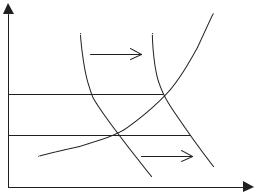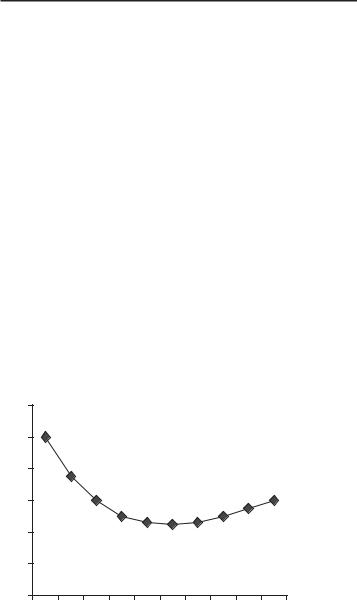
Cleaver Economics The Basics (Routledge, 2004)
.pdf
D1 |
D2 |
Supply |
|
||
Price |
|
|
P2 |
R |
|
P1 |
M |
N |
|
Quantity |
|
Figure 2.14 Demand, supply and price for sustainable coffee.
Assume the supply of smallholder coffee increases with price as indicated by the standard supply curve shown. Demand in the market place is given at first by the demand curve D1 but, over time, there is an increasing growth in consumer preferences for this traditional, environmentally friendly product such that demand shifts to D2.
If the old market price, P1, were to persist, supply would equal the distance P1M but demand would now exceed this, at P1N. The excess demand MN would force the price up in the market to a new premium price P2. Such a price induces more smallholders to enter the market, to certify their product and increase the supply of this sustainable coffee, corresponding to a movement along the curve, MR. Meanwhile, the price rise from P1 to P2 has reduced the demand somewhat, illustrated by the move NR. The new equilibrium quantity of coffee now traded has grown overall to the amount represented by the distance P2R (Box 2.8).
Thus we see the effect of changing consumer demand, transmitted by higher prices, signalling to producers that increased earnings and profits can be had by switching agricultural practices to more environmentally friendly techniques. By such market mechanics, induced by the ‘invisible hand’ of the price system, both the wishes of consumers and the needs of the planet are efficiently met.
These are the workings of the price mechanism – an automatic device that operates to balance supplies and demand for all goods and services marketed. There is no national or international government or bureaucracy involved, no official targets set and orders
© 2004 Tony Cleaver

Box 2.8 Sustainable coffee
The World Bank Rural Development Department identifies different standards of sustainability: organic coffee, which is grown without synthetic fertilisers and pesticides; shade-grown coffee, farmed under a forest canopy which provides different species habitat; and fair trade coffee which guarantees minimum prices and a living wage for poor farmers when world market prices are low.
To qualify for certification in any of these categories, farmers or small producer co-operatives must establish appropriate monitoring and documentation of their agricultural practices for a number of years. This can be an expensive process. Investment in these procedures is essential however both for convincing buyers that their product is genuinely complying with sustainability criteria and to ensure a high quality taste. Gaining access to high value markets is the key to success. This is critical if producers are to reap the rewards for the costly and timeconsuming expenditures necessary to certify their product. A substantial reduction in yields (down by 66 per cent!) can be expected at first if farmers switch from high chemical inputs to organic or shade-grown methods. Studies show that it may take up to five years for yields to recover. The longer-term pay back will be high since environmentally beneficial practices do not exhaust the soil, but in the meantime punishing costs must be endured.
Provided marketing links can be established, long term contracts with coffee buyers in niche European and North American markets can ensure access to significant price premiums that can generate high farm incomes, even if yields are lower. There are external benefits too. Higher farm incomes mean that the exodus of young people to city slums in poor countries is reduced, as is the temptation to farm illegal crops. Additionally, the process of certification and the requirements of village level organisation together promote entrepreneurial practices that have a direct educational and developmental benefit that may impact on a wide range of rural activities. Environmentally sustainable farming thus may produce a sustainable rural economy.
© 2004 Tony Cleaver

given – other than private contracts signed to purchase supplies and promise payments. The prices paid and earnings gained are not designated by some central authority and any changes that take place are not necessarily planned or co-ordinated – they are solely the outcome of privately agreed deals between buyer and seller. But the result is that due to the combined efforts of dealers all pursuing their own interests we can buy a decent drink at an affordable price in a local coffee shop.
The free market may, as we have seen, reward people sometimes arbitrarily and, according to its critics, unfairly (we will return to this theme in a later chapter) but the system works and adjusts efficiently to exogenous shocks that are part and parcel of the world we live in. It signals where people can work for profit, which production techniques are best employed and what goods and services serve society’s needs most. Quite some mechanism!
Summary
•Resources transfer their employment in response to price/income signals, subject to their occupational mobility.
•Consumers buy those goods and services that maximise their utility, subject to income constraints. A change in price of any one good that a consumer purchases represents a marginal change in real income such that it may effect a change in consumption patterns of this good and/or others.
•Demand or supply for any good is said to be price-elastic if it is very responsive to a change in price; price-inelastic if not.
•Other factors which affect demand for goods can be consumers’ incomes, tastes, advertising, etc. Other factors affecting the supply of goods and services can be sudden changes in costs or technology or exogenous shocks and disasters.
•Any change in the factors affecting market demand or supply will trigger price changes and thus a reappraisal of consumer and producer decisions.
•A market society thus automatically responds to consumers’ wishes and exogenous shocks, and in so far as people want to buy environmentally friendly produce so the economy will react to those demands and evolve more sustainable production practices.
©2004 Tony Cleaver
F U R T H E R R E A D I N G
Friedman, M. (1953) Essays in Positive Economics, University of Chicago Press. This is a very readable classic on the philosophy of economics by the subject’s most famous and distinguished exponent.
The following are useful if you wish to follow up my references on the economics of coffee:
International Coffee Organization, Coffee Market Reports, www.ico.org
Sorby, K. (2002) ‘Coffee Market Trends’, World Bank background paper, June.
World Bank (2002) Agriculture Technology Notes, No. 30, June.
© 2004 Tony Cleaver

3
T H E B U S I N E S S O F S U P P LY
It is now time to analyse in more detail the factors that influence the supply of goods and services to market. How are resources organised in production and what are the economic constraints involved? How do costs and revenues impact on prices and outputs, and how does the state of business competition affect a firm’s decision-making? First of all, however, consider the very foundation stone of a market society.
P R I VAT E P R O P E R T Y
Private property rights represent a fundamental building block of modern, developed economies. Being able to define what is mine and what is yours enables us to trade, agree prices and thereby organise the allocation of society’s resources. Property rights are thus an essential starting point – if we cannot agree ownership today, we cannot bring together diverse resources, invest in production and distribute future rewards according to some arranged formula.
Peruvian economist Hernando de Soto has argued that what holds back people in poor countries is lack of legal title to the assets – land they live on and buildings they have constructed – they informally possess. Because their possessions are not legally recognised, people are not willing to pool capital and start a business. The risk is too great: they may lose what little they have and then have no legal
© 2004 Tony Cleaver
In modern capitalist states, however, one of the most important socio-economic inventions that underpinned the Industrial Revolution and drove subsequent economic growth was the creation of the JOINT STOCK COMPANY. Large numbers of owners of relatively small amounts of capital could together pool their assets, pledge this stockpile as security to raise even more in the form of bank loans and thereby equip a large factory, a ship or some other productive enterprise capable of securing future profits.
Not that production needs always to be on a large scale. But whether large or small, business cannot be conducted without rules, without contracts enforceable in law. A promise to deliver a given supply at some time in the future must be kept if economic organisation is to be successful. If people do not trust one another to complete a deal then no progress can be made. Everyone would have to provide everything for him or herself since no one else would be relied upon to fulfil their part of the bargain. What standard of living could you then aspire to if you had to provide for all your own shelter, clothing, food and transport – let alone other, less urgent needs? Yet, this is precisely the reality faced by many in societies that fail to codify private capital.
Property rights protect owners and facilitate trade. Specialisation becomes possible. Market values can be estimated and this allows for subdivision and exchange through time. You can buy or sell a share of some existing or future asset and have the confidence you can retain this long term, so that when you die this property will be passed on to your heirs. Such confidence in the future promotes investment and thus growth.
Poor peasants, meanwhile, who may have farmed communal lands for ages may have no recognised assets, no means to raise capital, no pathway to increasing incomes. Quite the opposite, they risk eviction if they have no formal title to the lands they work on and they may lose any crops or livestock they may possess if they cannot physically defend them.
C A P I TA L , I N V E S T M E N T A N D G R O W T H
CAPITAL is a stock of assets capable of producing consumer goods and services. It will include a business’s plant and machinery, its resources in the process of production and even abstract concepts
© 2004 Tony Cleaver
such as its logo, certain business ideas and customer ‘goodwill’ – providing that they can be defined in law and ascribed a value.
INVESTMENT is a flow of funds that is devoted to creating more capital. It may be from funds retained out of past profits, or from private savings or it may be loans gained from a bank, but the action of allocating finances to build capital stock defines investment.
For existing production to be maintained in any business it requires that old capital stock is replaced as it wears out (DEPRECIA- TION) and to secure growth, capital stock must be added to. Investment must respond to both business needs. In addition, as capital stock increases so requirements for other resources (land, labour) will change and it is most likely, for example, that a business will also need to invest in its labour force or its HUMAN CAPITAL with improved training programmes.
The relationship between land, labour and capital and the effects of increased investment lie at the heart of analysis of production and market supply. We resort to economic theory to clarify the issues involved.
P R O D U C T I O N T H E O R Y
Increasing the supplies of any consumer good or service requires the relevant producers to employ more resources and/or to increase the PRODUCTIVITY of each resource. Leaving aside productivity for the moment, consider the issue of how many and what sort of factors of production to employ. What is the ideal mix of resources to secure the most efficient level of output for any one consumer good and also, given this factor combination, is there some ideal size or scale of enterprise to produce the good or service in question?
The first question relates to the optimum employment ratio of land/labour/capital; the second refers to the OPTIMUM SIZE OF FIRM.
T h e L a w o f D i m i n i s h i n g R e t u r n s
If an entrepreneur experiments with employment ratios to find the ideal blend of, say, labour to capital in production, he/she will run up against one of the oldest laws in economics. Consider the employment of labour and capital in, for example, running a coffee shop in the centre of town.
© 2004 Tony Cleaver
What would your choices be if you were the entrepreneur making the business decisions? Suppose first of all that the service you provide is winning you lots of custom – people are queuing up to come in to your premises. Clearly you want to expand the service – sell more coffee and make more profits – but if there are so many customers that you cannot maintain the same high standards, you will lose the opportunity to make money as potential sales are lost to rival suppliers. Solution: employ more waiters and bar staff. Taking on one more worker may boost sales and profits significantly. If customers keep on coming, you may need to employ more, and more labour.
But what about capital equipment? Additional seating, the crockery and cutlery, the espresso machine, and so on? If there is no corresponding increase in these inputs to match the increase in labour to your business then you cannot expect your profits to keep growing.
If all other factors remain fixed, therefore, each additional input of labour soon results in the increase in gains being eroded. What at first may have led to a 25 per cent increase in outputs may soon lead to an increase of, say, 10 per cent then 5 per cent then 2 per cent then less and less. Each additional worker hired brings falling benefits. It is the law of diminishing returns: a principle as old as economics itself. Output grows with additional inputs – but in steadily decreasing amounts. There is clearly a limit to how much growth can be stimulated if you continuously increase employment of only one factor where others are fixed. (This law was famously outlined by Thomas Malthus in 1798 who argued that there was a tendency of the population, if unchecked, to increase faster than the food supply until poverty for all resulted. More and more people trying to farm the Earth would lead to smaller and smaller increases in outputs: a pessimistic scenario shared by many environmentalists today.)
This having been said, there are still great differences between businesses as to what is the optimum combination of capital to labour and, therefore, when the point of diminishing returns sets in. Generally speaking, service industries tend to have a higher proportion of labour to capital compared to manufacturing – but even that is changing. Improvements in technology embodied in the latest capital equipment can, for example, greatly increase productivity, increase the most efficient capital/labour ratio and
© 2004 Tony Cleaver
thereby postpone the onset of diminishing returns to the employment of capital. (This may change the demand for labour – creating jobs for some, creating unemployment for others. Information technology has completely transformed employment in banks and financial services, for example. Far fewer office clerks and secretaries are now employed per unit of capital in such workplaces whereas higher skilled job opportunities have mushroomed.)
T h e O p t i m u m S i z e o f F i r m
Whatever the eventual decision on which mix of land, labour and capital to employ in production, assuming a given state of technology, what happens if all inputs are, say, doubled? The same mix of resources is maintained but now at a much larger scale of enterprise – does efficiency increase or decrease?
The results can be measured by considering the average costs (ACs) of production. Does the unit cost of producing, say, a cup of coffee, or a haircut, or public transport, or a barrel of oil, increase or decrease as the scale of production increases?
Answers differ according to the product in question. In general, the more the consumers want a standard, homogenous product the more this will lend itself to large-scale production. In contrast, the more individualised the good or service in demand, the smaller will be the most efficient size of firm. Oil refineries therefore can be huge, capital-intensive complexes that churn out millions of litres of petrol per day – each one identical in its composition (car engines wouldn’t work if the chemical content was variable). Meanwhile a giant, centralised hairdressers supplying indentikit haircuts is unlikely to efficiently meet consumer demand.
As demonstrated, the optimum size of firm will differ between industries according to the nature of the product in demand and the technical possibilities in production but, in addition to this, most if not all businesses will experience a similar cost–efficiency relationship as they vary their own scale of production.
E c o n o m i e s a n d D i s e c o n o m i e s o f S c a l e
Starting at low production levels, ACs of production will be initially high and, as scale increases, efficiency is likely to increase – and unit
© 2004 Tony Cleaver

costs fall – until the optimum size is reached. Beyond this point, inefficiencies begin to appear in the production process and unit costs begin to rise again (Table 3.1 and Figure 3.1). What are the reasons for this pattern of costs? They relate to the balance of advantages and disadvantages of bigness in business.
Table 3.1 A typical profile of average production costs.
Output |
Total cost |
Average cost |
|
|
|
1 |
100 |
100 |
2 |
150 |
75 |
3 |
180 |
60 |
4 |
200 |
50 |
5 |
230 |
46 |
6 |
270 |
45 |
7 |
322 |
46 |
8 |
400 |
50 |
9 |
495 |
55 |
10 |
600 |
60 |
|
|
|
Note
The optimum scale of output in this example is at 6 units.
120 |
|
|
Average costs |
|
|
|
|||
|
|
|
|
|
|
|
|
|
|
100 |
|
|
|
|
|
|
|
|
|
80 |
|
|
|
|
|
|
|
|
|
60 |
|
|
|
|
|
|
|
|
|
40 |
|
|
|
|
|
|
|
|
|
20 |
|
|
|
|
|
|
|
|
|
0 |
|
|
|
|
|
|
|
|
|
1 |
2 |
3 |
4 |
5 |
6 |
7 |
8 |
9 |
10 |
|
|
|
|
Output |
|
|
|
|
|
Figure 3.1 A typical profile of average production costs.
© 2004 Tony Cleaver
